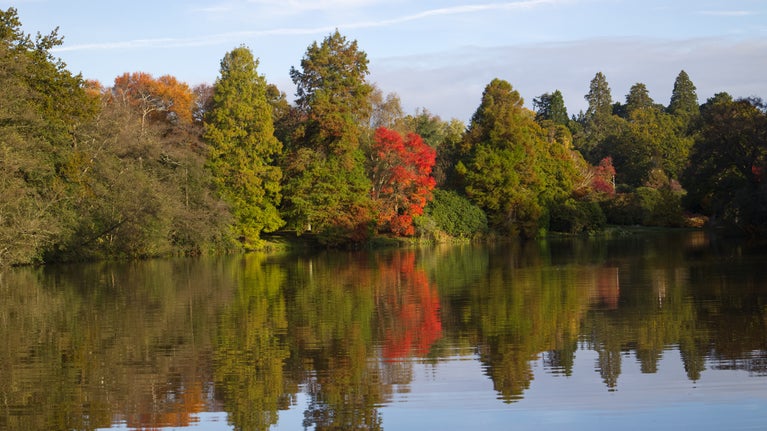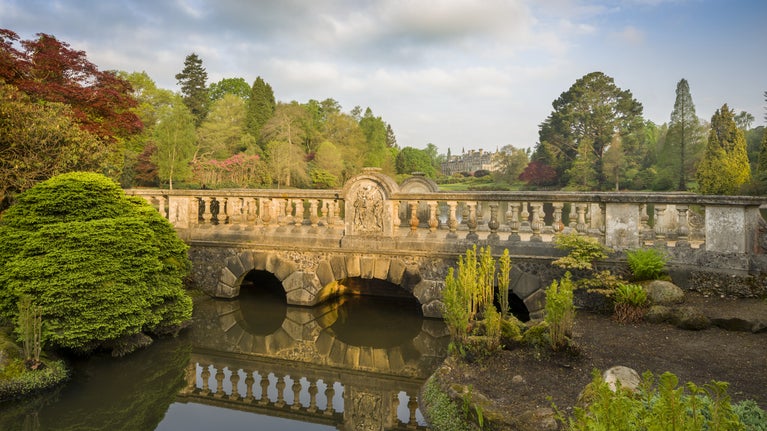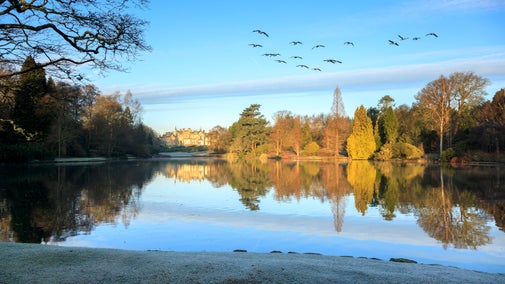
Discover more at Sheffield Park and Garden
Find out when Sheffield Park and Garden is open, how to get here, the things to see and do and more.

Sheffield Park and Garden is one of the most significant landscape gardens in England. Originally a Tudor deer park, the gardens were transformed in the 18th century for John Baker Holroyd, the 1st Earl of Sheffield. The result was the vision of leading landscape designers Lancelot ‘Capability’ Brown and Humphry Repton. In the 19th century, Henry North Holroyd, the ‘cricket-mad’ 3rd Earl augmented the gardens. In the 20th century Arthur Gilstrap Soames introduced new, ‘exotic’ species collected from across the globe.
Sheffield Park and Garden’s historic roots run deep. Originally it was an estate given to the Norman noble, Robert, Count of Mortian (c.1031–c.1095), who was the half-brother of William the Conqueror. In 1086 it was listed in Domesday Book as ‘Shelle’. In the 13th century, the estate belonged to Simon de Montfort, 6th Earl of Leicester (c.1208– 1265), who led the revolt against Henry III, known as the Second Barons’ War. In the 16th century, Thomas Howard, 3rd Duke of Norfolk (1473–1544), a prominent Tudor courtier, acquired the estate, then known as Sheffield Place. He likely built the relatively modest, Tudor brick mansion on the site.
Howard was Henry VIII’s Lord High Treasurer and uncle to two queens of England – Anne Boleyn and Catherine Howard. The King visited Sheffield Place on one occasion when Thomas Howard organised a special hunt in his honour. In the mid-18th century, the estate became the property of the De La Warr family who, in 1769, sold Sheffield Place to an ambitious politician – John Baker Holroyd, 1st Earl of Sheffield (1735–1821). It is Holroyd who transformed the park and garden into the beautiful English landscape garden that we see today.
Unlike the previous owners of Sheffield Place, John Baker Holroyd did not come from an aristocratic background. Born in 1735, he was the son of a lawyer. His great friend, the historian Edward Gibbon, described him as a ‘new man’ and ‘very self-important’.
He was made Earl of Sheffield in 1816.
Having inherited a substantial fortune in 1768 from his uncle, Holroyd acquired Sheffield Place, which he renamed Sheffield Park. Holroyd commissioned architect James Wyatt to rebuild the Tudor mansion in a fashionable ‘Gothick’ style, a recognised architectural style of the 18th century. Recognising the need for a suitable setting for the new house, he called in the services of the two most prominent landscape garden designers of the period, Lancelot ‘Capability’ Brown and Humphry Repton.
Unfortunately, we don’t have extensive information as to what Brown did at Sheffield Park. He likely landscaped Ten Foot Pond – a body of water directly in front of Wyatt’s new garden façade for the house. Brown probably also laid out some of the walks leading into the grounds, as well as creating the principal vistas in the landscape garden.
We know more about the work undertaken by Humphry Repton from 1789 to 1803. Letters describe the work he undertook, including opening views around the Second and Third Ponds on the Woman’s Way valley and re-landscaping some of the existing bodies of water. He wrote ‘…a very beautiful lake has been added to the scenery of [the] place, which abounds in the most perfect specimens of the picturesque effects produced by Gothic architecture.’
There are also notes documenting the number of trees and shrubs Repton advised Holroyd to acquire including: ‘…1,000 larch, 100 acacias, 260 silver firs, 200 chestnuts, 1,100 oaks (plus seedlings), 9,450 ash, 30 planes, 16 walnuts and 8 Portugal Laurels…’.
Holroyd was a Member of Parliament on two occasions – firstly as MP for Coventry between 1780 and 1784 and then again between 1790 and 1802 when he was MP for Bristol. Much of Holroyd’s work as an MP was concerned with maintaining Britain’s role as the major maritime trading power of the day. During this time, he actively opposed the abolition of slavery, publishing and speaking against it in 1790, and later voting against it in 1796.

Like his father and grandfather, Henry North Holroyd, 3rd Earl of Sheffield (1832–1909) entered politics as the Conservative MP for Sussex East from 1857 to 1865. However, at Sheffield Park he is best remembered for his passion for cricket.
The 3rd Earl was president of Sussex County Cricket Club from 1879 to 1897, and sponsored the Sheffield Shield cricket tournament in Australia, which is still played to this day. At Sheffield Park, he augmented the surrounding landscape park by Brown and Repton to create what was described as ‘the finest cricket ground in the kingdom’. He added innovative features to the garden, including the Pullham waterfall, which uses artificial rock. He also erected two cricket pavilions next to the cricket ground – including the highly ornate, cast iron ‘Ladies Pavilion’. Sadly, these buildings no longer survive.
W.G. Grace (1848–1915), considered to be one of England’s all-time greatest cricket players, played on the 3rd Earl’s cricket ground, and in 1896 the Australian team was hosted at the property. The match they played attracted 25,000 spectators, including the Prince of Wales (later Edward VIII). The 3rd Earl built a train station at Sheffield Park, allowing visitors to travel in comfort to the property. Unfortunately, the 3rd Earl’s liberal spending meant when he died in 1909, he left behind great debts.
In 1909, Arthur Gilstrap Soames (1854–1934), who had previously visited and admired the gardens, purchased the estate. Soames, whose family had made their fortune in the brewing industry, experimented with what would thrive in the soil and climate of Sussex. He brought in ‘exotic’ plants, building upon the knowledge of plants he developed from his travels to Sri Lanka.
Soames was also well-connected to significant American botanists, resulting in the introduction of many species from North America, including Swamp Cypress and Nyssa. Soames’s planting continues to provide the autumn colour for which Sheffield Park is celebrated. During the 1920s and 1930s Soames and his wife Agnes were renowned for the garden parties that they hosted at Sheffield Park.
With the outbreak of the Second World War, the days of Sheffield Park as a private residence were numbered. Arthur Gilstrap Soames died in 1934, leaving his widow, Agnes (1868–1964), the property (although the will was contested by Soames’s nephew – Arthur Granville Soames). As part of the war effort, the entire estate was requisitioned as a camp for the Canadian Army between 1942 and 1945. Nissan huts (housing for soldiers) covered a large part of the grounds.
Evidence of the camp mainly survives as archaeological features, although one hut still stands in what is now the gardeners’ compound. Known as Fletching Camp, Sheffield Park was home to multiple Canadian regiments and divisions.
Following D-Day, the camp was used for the training of Canadian reinforcements for the campaign in Europe. It finally became a Repatriation Depot between August and September 1945, when Canadian troops returned home.

The use of Sheffield Park as an army camp caused considerable damage to the park, garden and the house. Arthur Granville Soames successfully overturned his late uncle’s will, although he allowed the widowed Agnes to live on at Sheffield Park until 1949. Restoring the park, garden and house to its former beauty was beyond his financial ability, so in 1953, he sold Sheffield Park to a property development company who split up the estate.
In 1954, the National Trust bought the important garden by Capability Brown and Humphry Repton and later bought areas of the surrounding park. Unfortunately, the National Trust lacked the finances to also buy the house, which passed into private hands and, in the 1980s, was converted into flats.
Today, the National Trust looks after over 250 acres of garden and parkland at Sheffield Park, respecting the artistic vision of its designers – Lancelot ‘Capability’ Brown and Humphry Repton – as well as celebrating the experimental approach to gardening adopted by Arthur Gilstrap Soames. The legacy of the 3rd Earl also endures at Sheffield Park with cricket still played on the site of the historic cricket ground.
Cannon, John. ‘Holroyd, John Baker, first earl of Sheffield (1735–1821), politician.’ Oxford Dictionary of National Biography. May 24, 2012.
Daniels, Stephen. ‘Repton, Humphry (1752–1818), landscape gardener.’ Oxford Dictionary of National Biography. January 05, 2012.
Howat, Gerald M. D. ‘Grace, William Gilbert [W. G.] (1848–1915), cricketer and medical practitioner.’ Oxford Dictionary of National Biography. January 06, 2011.
Phibbs, John. ‘Brown, Lancelot [known as Capability Brown] (bap. 1716, d. 1783), landscape gardener and architect.’ Oxford Dictionary of National Biography. September 01, 2017.

Find out when Sheffield Park and Garden is open, how to get here, the things to see and do and more.
Explore a horticultural work of art at Sheffield Park in East Sussex, formed through centuries of landscape design, famed for its autumn colour but beautiful in every season.

Explore over 250 acres of wide-open spaces and dramatic skies at Sheffield Park and Garden. Look out for butterflies, buzzards or skylarks and the historic remains of its past.

Find out how the Heritage Lottery Fund is helping to transform the River Ouse at Sheffield Park as part of a major river restoration project.
Sheffield Park is a two pawprint rated place. We love dogs at Sheffield Park, find out more about where and when you can walk on and off the lead and our dog-friendly facilities.

Lancelot 'Capability' Brown was one of the UK's most celebrated landscape gardeners. Find out how this Georgian gentleman created the quintessential English landscapes that we see at many of the places in our care today.

Find out the National Trust places you can visit to see the dramatic landscapes created by Humphry Repton, one of Britain’s best-loved landscape designers.

Learn about people from the past, discover remarkable works of art and brush up on your knowledge of architecture and gardens.
